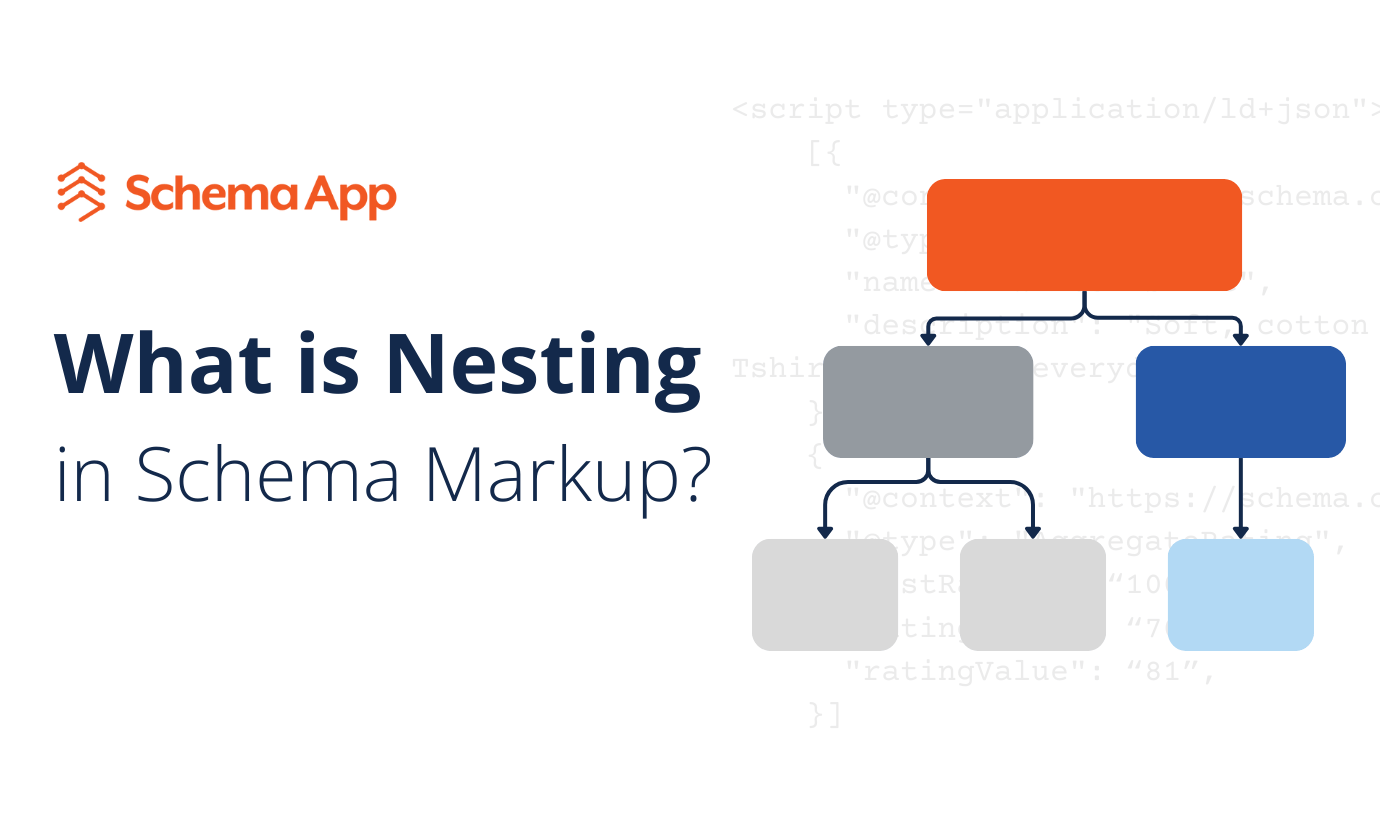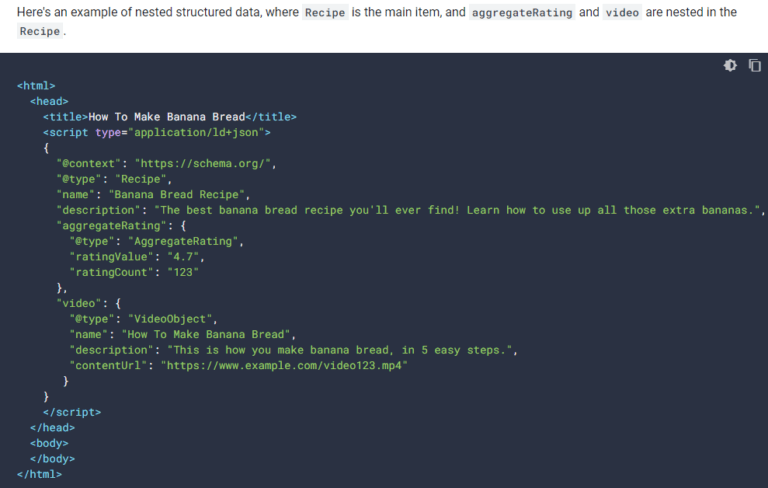
Nesting in Schema Markup refers to the practice of structuring your markup hierarchically by grouping additional relevant entities on a web page under a defined main entity of the web page within your markup.
This approach communicates clear relationships, giving machines context about the different entities described on your web pages. By improving search engine understanding of your content, it can lead to better visibility and more accurate presentation in search results.
Here’s a breakdown of nesting in Schema Markup:
Main Entity: This is typically the primary entity or item that your webpage is about. For example, if you’re describing a recipe page, the Recipe itself would be the main entity.
Nested Entities: These are secondary entities on the page that are closely related to the main entity. For instance, if your main entity is a Recipe, nested entities could include AggregateRating and VideoObject.
Why is it Important to Nest your Schema Markup?
Nesting your Schema Markup serves several purposes:
- It clarifies the relationships and hierarchy between different entities defined on your web page.
- It helps build your content knowledge graph.
Nesting Helps Clarify Hierarchy and Entity Relationships
When implementing Schema Markup, many SEOs often create separate markups for multiple entities on a single page. For example, a page might feature a product along with its color variations and also include reviews and ratings of the product. All this visible content should be marked up with structured data.
However, if you specify each of these entities separately, you miss the opportunity to clearly communicate to search engines the primary focus of your page and the relationships between these entities. Are the reviews and ratings specific to that product, or are they unrelated to the product and pertain to the organization selling it?

This example shows that structuring your entities in a clear hierarchy helps search engines better understand the properties associated with your defined entities and how they all relate to each other.
This leads us to our second purpose for nesting your markup: the development of your knowledge graph.
Building Your Content Knowledge Graph Using Nested Schema Markup
Implementing nested Schema Markup is crucial for building a robust content knowledge graph. A knowledge graph is a collection of relationships between things, aka “entities,” defined using a standardized vocabulary, like Schema.org, from which new knowledge may be gained through inferencing.
Simply put, it is a way to organize your website content into a graph of interconnected entities, enabled through connected Schema Markup.
As search engines advance with AI technologies, establishing a well-defined and interconnected knowledge graph for your organization using Schema Markup is critical to staying ahead. AI search engines can utilize your structured data to uncover new insights about your organization and interpret valuable information from your website’s content and relationships more effectively.
This, in turn, allows your content to show up more accurately and relevantly for user queries.
Additionally, you can use your content knowledge graph to support internal AI initiatives and LLMs like ChatGPT. You can learn more about that in this article.
How do you Nest Schema Markup?
Now that you know what nesting is and why it’s important, it’s time to dive into the “how.” Nesting your Schema Markup can be broken down into several steps.
1. Identify the Main Entity
Determine the primary entity or topic of your web page. The main entity is easier to identify on some pages than others. If you’re unsure which Schema.org type to use, ask yourself what the intent of the page is. Is it selling something? If so, it’s likely a Product or Service. Is it informing an audience about a particular topic? In that case, it’s probably an Article or Blog Posting.
2. Identify Related Entities
Identify the other entities on the page that are associated with the main entity. For example, if your main entity is a Recipe, the webpage containing that recipe may also contain information about the author, reviews and ratings, or even a video showing the steps in the process. Each of these “things” is a related entity that you’ll want to represent in the structured data about that Recipe.
3. Implement a Nested Structure
Use the correct properties to connect your main entity and related entities together. In our Recipe example, we might use the author, review, aggregateRating, and video properties to connect the related entities we identified in the previous step.
Going to the Schema.org page associated with the type of your main entity will help you figure out which properties are available to that type. However, many types have more than 40 properties available to them, so finding the right one can be challenging.
Good news! If you’re unsure which Schema.org properties you should use to connect your entities, you can use our free Schema Paths Tool to identify all possible connections. To use this tool, select the two Schema.org types you want to connect, and it will output all the available properties that connect the two types.
The Schema Paths Tool in the image below shows that you can connect Recipe and VideoObject entities using a number of different properties. In our case, the subjectOf or video properties would both work. But since Recipe is eligible for a rich result, we would also want to consult Google’s Structured Data Documentation to see what they recommend. In this case, VideoObject should be connected to a Recipe using the video property.

Read our article for more information on how to use the Schema Paths Tool.
4. Validate your Schema
The Schema Validator will show all the markup on a single webpage and check for any syntax errors in the code. If the Schema Markup you’ve added aims to achieve a rich result, Google’s Rich Results Test will help you test which rich results your page is eligible for based on the structured data it contains.
5. Maintain Hierarchy
Keep in mind that effective Schema Markup requires ongoing maintenance and management, as on-page content and Google’s structured data requirements are subject to change. This ongoing maintenance will prevent schema drift and ensure you are optimizing your markup for search engine comprehension.
When Shouldn’t You Nest Schema Markup?
If the entities on your page are distinct and unrelated, nesting them within a hierarchical structure may not accurately represent the content. For example, a page featuring both a recipe and a list of unrelated events should use separate Schema Markup for each entity instead of nesting them together.
Additionally, some Schema types and properties are designed to be standalone and should not be nested within other types. For example, BreadcrumbList is used for navigational purposes, while the rest of your Schema Markup is probably intended to represent the meaning (semantics) of the page’s contents. As a result, these markups should not be nested.

Start Nesting Your Schema Markup Today
Implementing proper nested Schema Markup requires expertise and ongoing maintenance. Before worrying about nesting your markup, you must ensure your markup first aligns with your page content and that your entities are properly defined. Although this adds to the challenge, the benefits of this approach can significantly enhance your semantic SEO and provide your organization with agility in response to AI-driven search.
As we rapidly approach a future where AI powers search engines, you can implement nested Schema Markup to help them infer and access new knowledge about your organization. This can improve your visibility to potential customers in search results.
At Schema App, we understand the importance of nested Schema Markup and have designed our solution to help you easily create, connect, and manage your markup.
Don’t let the complexity of Schema Markup hinder your success. Get in touch with us to learn more about our end-to-end Schema Markup solution.

Jasmine is the Product Manager at Schema App. Schema App is an end-to-end Schema Markup solution that helps enterprise SEO teams create, deploy and manage Schema Markup to stand out in search.




